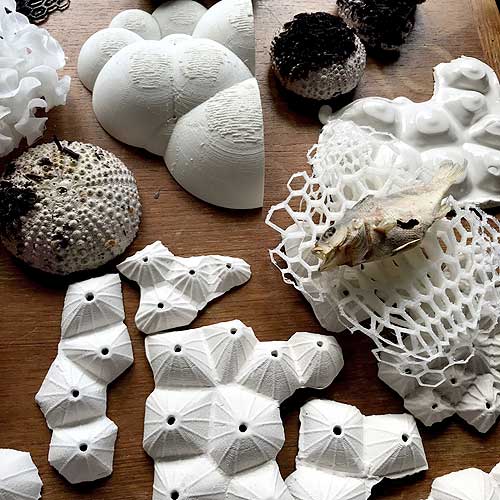

| pro | 2005/05 - 2008/02 extension and restauration of a house from the 50th, in the golden ground |
| material | exposed concrete, oak, coated steel, linoleum, zink |
| client | katja & brian jones |
| engineers | bollinger-grohmann, ffm |

Exhibition: ‘Future Nature - Synthetic Biologies’
reinhardtjung’s research on synthetic biologies (shells, corals, and other marine specimen in mathematical code and advanced manufacturing) was exhibited at TU Delft, The Netherlands, until April-May, 2018.
Link:
24 April 2018 00:00 till 09 May 2018 00:00 - Location: Faculty of Architecture and the Built Environment, Zuidserre, https://www.tudelft.nl/en/events/2018/bk/exhibition-future-nature-synthetic-biology/
Description:
Our world is rapidly changing, and in the epoch of Anthropocene human impacts on the environment need to be considered carefully. The Great Barrier Reef is in danger, and so synthetic biologies – digitally manufactured systems - may provide a support for raising awareness for endangered species that are on the brink of extinction due to temperature rises.
‘Synthetic Biologies’ relates to a context of contemporary architecture design that applies biological methods and systems as found in nature. Parametric formulas, algorithmic scripts, and processing codes provide simple component rules that privilege the general over the specific, and so allow the production complex forms. Whereas morphologies and self-forming processes are currently adopted by architects as a machinic logic of design, often, relationships between matter, process and experience have become dissociated. In contrast to digital mechanics of computational design approaches, ‘Synthetic Biologies’ reaches back towards the predecessors of the digital; interpolating between biological systematization (D’Arcy Thompson), structural analysis (Frei Otto), and architectural geometries (Peter Pearce, Buckminster Fuller). The research sets these geometrical or mathematical approaches in relation to Jane Benyus’s notion of biomimicry, a field that understands nature as a laboratory working through three levels; as natural form; as natural process; and as natural systems.
‘Synthetic Biologies’ investigates a language potentially shared between interdisciplinary fields of biology, mathematics, behavioural studies, interaction design and architecture. This research creatively deploys and explores such language by reworking natural paradigms through interactive, responsive media installations in objects and prototypes, made by robotic fabrication and advanced manufacturing techniques. By exploring the way code becomes matter, and the way coded matter informs behaviour, an interdisciplinary discourse is initiated. Synthetic Biologies’ communicates mathematical principles in natural forms through computational and synthetic matter, so that effects and affect are encouraged, and sensory (emotional, experiential) engagement can be embedded.